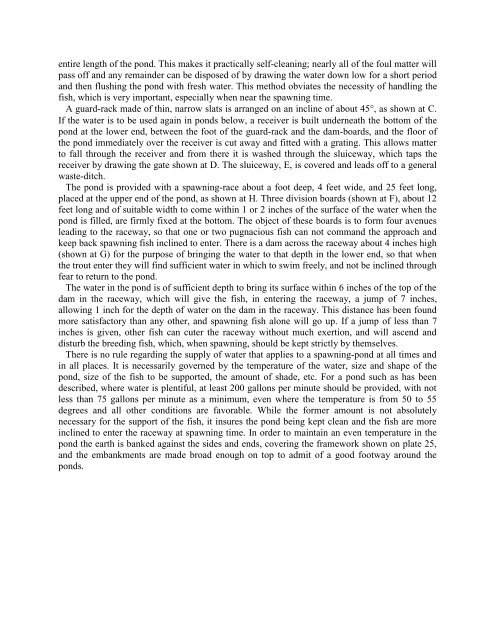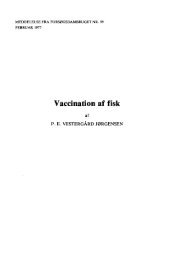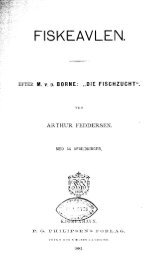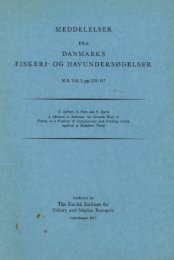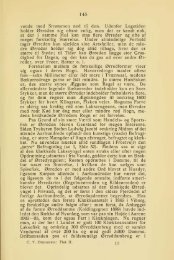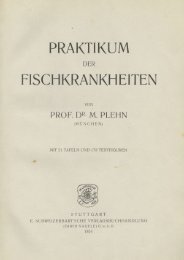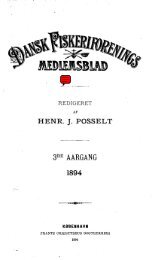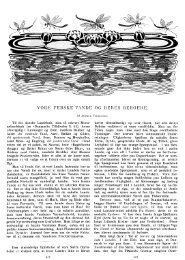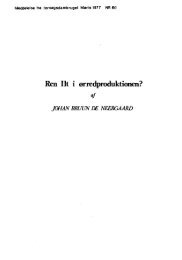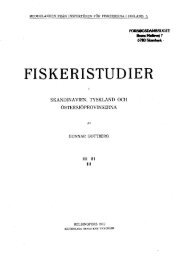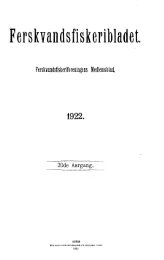Create successful ePaper yourself
Turn your PDF publications into a flip-book with our unique Google optimized e-Paper software.
entire length of the pond. This makes it practically self-cleaning; nearly all of the foul matter willpass off and any remainder can be disposed of by drawing the water down low for a short periodand then flushing the pond with fresh water. This method obviates the necessity of handling thefish, which is very important, especially when near the spawning time.A guard-rack made of thin, narrow slats is arranged on an incline of about 45°, as shown at C.If the water is to be used again in ponds below, a receiver is built underneath the bottom of thepond at the lower end, between the foot of the guard-rack and the dam-boards, and the floor ofthe pond immediately over the receiver is cut away and fitted with a grating. This allows matterto fall through the receiver and from there it is washed through the sluiceway, which taps thereceiver by drawing the gate shown at D. <strong>The</strong> sluiceway, E, is covered and leads off to a generalwaste-ditch.<strong>The</strong> pond is provided with a spawning-race about a foot deep, 4 feet wide, and 25 feet long,placed at the upper end of the pond, as shown at H. Three division boards (shown at F), about 12feet long and of suitable width to come within 1 or 2 inches of the surface of the water when thepond is filled, are firmly fixed at the bottom. <strong>The</strong> object of these boards is to form four avenuesleading to the raceway, so that one or two pugnacious fish can not command the approach an<strong>dk</strong>eep back spawning fish inclined to enter. <strong>The</strong>re is a dam across the raceway about 4 inches high(shown at G) for the purpose of bringing the water to that depth in the lower end, so that whenthe trout enter they will find sufficient water in which to swim freely, and not be inclined throughfear to return to the pond.<strong>The</strong> water in the pond is of sufficient depth to bring its surface within 6 inches of the top of thedam in the raceway, which will give the fish, in entering the raceway, a jump of 7 inches,allowing 1 inch for the depth of water on the dam in the raceway. This distance has been foundmore satisfactory than any other, and spawning fish alone will go up. If a jump of less than 7inches is given, other fish can cuter the raceway without much exertion, and will ascend anddisturb the breeding fish, which, when spawning, should be kept strictly by themselves.<strong>The</strong>re is no rule regarding the supply of water that applies to a spawning-pond at all times andin all places. It is necessarily governed by the temperature of the water, size and shape of thepond, size of the fish to be supported, the amount of shade, etc. For a pond such as has beendescribed, where water is plentiful, at least 200 gallons per minute should be provided, with notless than 75 gallons per minute as a minimum, even where the temperature is from 50 to 55degrees and all other conditions are favorable. While the former amount is not absolutelynecessary for the support of the fish, it insures the pond being kept clean and the fish are moreinclined to enter the raceway at spawning time. In order to maintain an even temperature in thepond the earth is banked against the sides and ends, covering the framework shown on plate 25,and the embankments are made broad enough on top to admit of a good footway around theponds.


